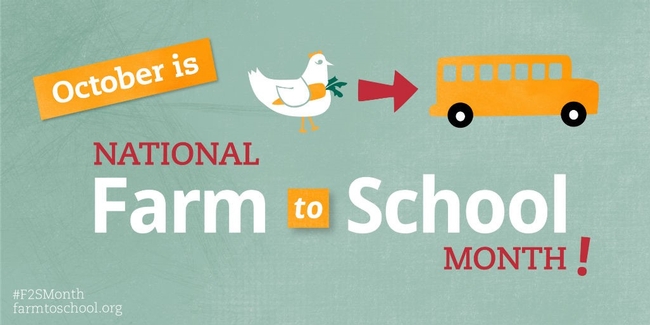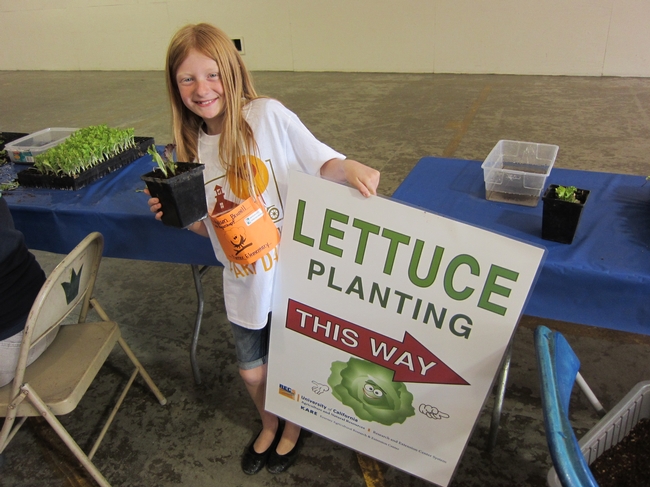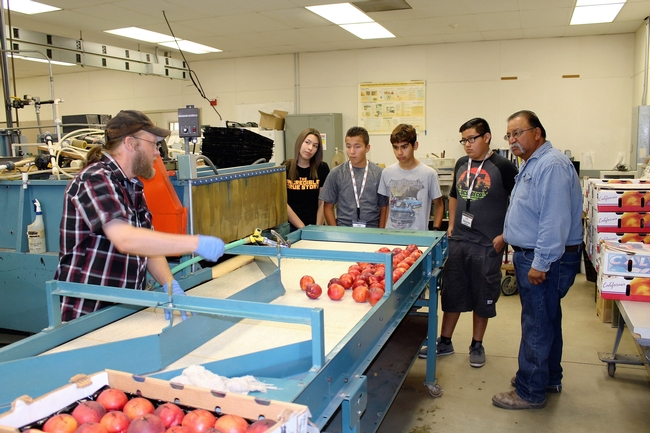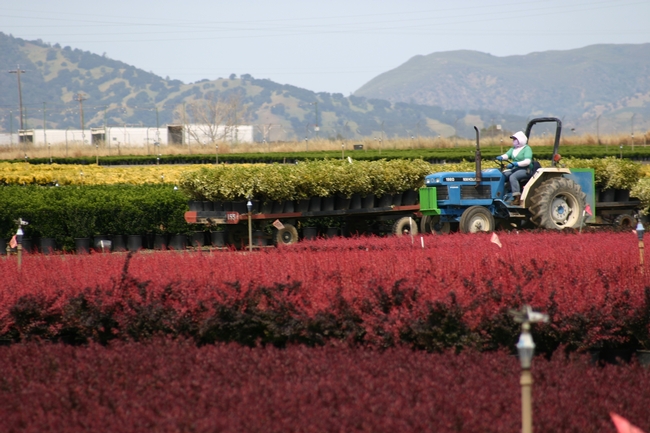Posts Tagged: assessment
October is National Farm-to-School Month
Schools across the country are celebrating local connections to local food producers in October during National Farm to School Month. Education and outreach activities such as school gardens, cooking lessons and field trips are teaching students about healthy, local foods and food's journey from the farm to their forks.
There are plenty of opportunities for teachers and schools to celebrate and get involved in National Farm to School Month with the University of California Division of Agriculture and Natural Resources (UC ANR). Here are a few ideas to get you started.
4-H youth development
Launch a 4-H Club at your school. The 4-H Youth Development Program emphasizes enrichment education through inquiry-based learning. Core content areas include Healthy Living as well as Science, Technology, Engineering and Math (STEM). Clubs have access to a wealth of curricula materials exploring food, agriculture and natural resources. 4-H also offers the Ag in the Classroom school enrichment program.
Boots on the ground
Invite UC ANR academics and program staff to your career day or science fair or to make a classroom presentation. Specialists from Master Gardeners, Nutrition Education, Project Learning Tree, California Naturalist and other UC ANR programs know how to engage and inspire your students.
Some programs, including Project Learning Tree, offer "train the trainer" professional development workshops that equip educators with the skills and knowledge to teach concepts in their own classrooms. Project Learning Tree also provides free activity guides to teachers who attend their workshops. The guides highlight differentiated instruction, reading connections, and assessment strategies and offer ideas to integrate technology into classroom instruction,
Research and Extension Centers
Take your students on a field trip to a UC ANR Research and Extension Center (REC). The nine RECs in California are focal points for community participation and for active involvement in current and relevant regional agricultural and natural resource challenges.
Visiting a REC offers students a unique opportunity to learn about food production through the lens of applied science research in plant pathology, integrated pest management, conservation tillage, water conservation, development of new crop varieties, and much more. Some RECs also host extended education programs such as Sustainable You! Summer Camp and FARM SMART.
The 2016 National Farm to School Month theme is One Small Step, which highlights the easy ways anyone can get informed, get involved and take action to advance farm to school in their own communities and across the country.
Each week will have a different focus:
- Education (October 3-7)
- Healthy School Meals (October 10-14)
- Farmers & Producers (October 17-21)
- The Next Generation (October 24-28)
Join the celebrations by signing the One Small Step pledge then take your own small step to support healthy kids, thriving farms and vibrant communities this October by partnering with UC ANR.
This story en español.
UC to measure energy and greenhouse gas footprints of orchard crops
A new study underway at the UC Sustainable Agriculture and Research and Education Program (SAREP) aims to help growers and policymakers better understand the energy use, greenhouse gas emissions, and carbon sequestration potential of orchard systems throughout California.
As trees grow, they draw carbon dioxide from the air to create sugar and cellulose for food and growth, locking some of that carbon into their wood as the trees age — in some trees for 25 years, in others like walnuts, for upwards of 150 years. Proper use of that carbon at the end of an orchard's life can have major implications for the overall greenhouse gas footprint of an orchard operation. Trees used for power generation after orchard removal have the potential to offset fossil-fuel related emissions created throughout the orchard's life.
"Our preliminary study in almonds shows that the amount of fossil fuel emissions saved in this way is equal to almost three-quarters of the greenhouse gas emissions generated during the whole 25-year lifespan of the orchard, using current practices," says the project's director, Sonja Brodt, SAREP academic coordinator. "We think that this information could help to position orchard crops favorably for a consumer base that is increasingly climate-smart."
This study, funded by the California Department of Food and Agriculture's Specialty Crops Block Grant Program, will focus on prunes, peaches, walnuts and almonds in all of the primary production regions of the state.
Many farm management practices have an energy use component that the project will consider including water and fertilizer use, tractor use and post-harvest transportation. By understanding which parts of orchard operations use the most energy as well as how much energy is required to manufacture and distribute inputs before they even arrive at the farm, growers can increase the efficiency of their practices. Industry groups can also develop more scientifically-sound grower sustainability programs to improve energy efficiency more broadly for the state's many tree crop growers.
"Energy is one input into agriculture that we have not thought about much from a whole supply chain point of view," says Gabriele Ludwig of the Almond Board of California, which funded a preliminary study on energy use and emissions in almond production and handling. "Yet the costs of energy, especially from fossil fuel sources, keep going up. The life cycle assessment approach used in this project can provide an analysis of where increased efficiencies may be possible."
The project's collaborators include the UC Cooperative Extension's Sutter-Yuba office, the UC Davis Department of Civil and Environmental Engineering, Department of Land, Air, and Water Resources, the Department of Plant Sciences, and graduate students in Horticulture and Agronomy and International Agricultural Development.
By working with growers throughout the state, project staff will be able to ensure that orchard management practices included in the project's models are representative of current practices. Growers interested in providing confidential input about their orchard practices are invited to contact Brodt at sbbrodt@ucdavis.edu or (530) 754-8547.
Accurate, site-specific knowledge of fertilizer use in California needed
Nitrogen fertilizer has undoubtedly benefited California's agriculture and citizens. However, applying more nitrogen than can be used by plants may lead to negative impacts on the environment and human health. Finding a balanced use of nitrogen to maximize benefit and minimize harm is essential to protect California's agriculture, people and natural resources.
As California legislators focus on nitrogen use in agriculture and its ability to contaminate groundwater, potential regulation on fertilizer use will require solid information on the amount of fertilizer used by California farmers, and the extent to which that usage contributes to environmental pollution. A new study published in California Agriculture evaluates trends in fertilizer use by California's major crops. It also shows that major deficiencies in data collection need to be addressed in order to develop effective policies regarding fertilizer use.
The publication is one of the first peer-reviewed articles to emanate from the California Nitrogen Assessment (an ongoing project at UC Davis). Assessment research documents that while there are many pathways through which nitrogen can enter the environment, inorganic fertilizer use is responsible for the largest fraction of new nitrogen introduced into California annually. Currently, over 600,000 tons of nitrogen fertilizer are sold in the state each year.
Information on fertilizer sales, however, is not an accurate indicator of fertilizer application, and authors found that fertilizer use data is not easy to come by — either because it is not tracked at relevant scales or because data sources are inconsistent.
"We found ourselves with very limited information to understand an issue with sweeping implications for California agriculture,” says Todd Rosenstock, the article's lead author. "We dug deep to create an accurate picture of fertilizer use in the state, but the remaining gaps will require attention.”
To estimate the amount of nitrogen applied to different crops around the state, authors aggregated data from different sources, including grower surveys and University of California studies, and show application rates for 33 of California's major crops.
While nitrogen fertilizer use on a crop-by-crop basis has risen over the last three decades, this increase has been more modest than fertilizer sales suggest. Between 1973 and 2005, fertilizer sales increased 31 percent, but nitrogen application rates increased on 25 percent across the 33 crops studied. Both data sets reflect increased nitrogen application and a shift to growing more nitrogen-intensive crops.
For many crops, nitrogen use increases have been accompanied by well-recorded yield increases — at rates that show nitrogen's benefit, and also suggest that farmers may be becoming more agronomically nitrogen-efficient, requiring less nitrogen per unit of production.
"In the absence of good information, we could do the wrong thing,” says Tom Tomich, co-author of the article and director of the Agricultural Sustainability Institute at UC Davis.
"Regulation without supporting data could fail to address the heart of the problem, or could damage agriculture,” says Tomich, who is also professor in the Department of Environmental Science and Policy at UC Davis, W.K. Kellogg Endowed Chair in Sustainable Food Systems and director of Sustainable Agriculture Research and Education Program. "Better information on nitrogen use is indispensable to collaborative development of effective solutions that can increase nitrogen use efficiency and save farmers money.”
The article makes recommendations on how data could be better compiled to improve our understanding of statewide trends in fertilizer use. To read the article, visit http://ucanr.edu/calagnassessment.
This article is part of an ongoing study, the California Nitrogen Assessment (CNA), a project of the Agricultural Sustainability Institute at UC Davis and UC Sustainable Agriculture Research and Education Program. The CNA reviews existing data on nitrogen to draw connections between nitrogen use, surplus, and established environmental and human health effects of excess nitrogen. The CNA is a stakeholder-driven assessment that seeks public input on its research and products. To learn more about the California Nitrogen Assessment, visit http://nitrogen.ucdavis.edu.
Olive trees to be added to ag assessment program
The California Senate Agriculture Committee has approved a bill that would add oil olive trees to the list of crops that are subject to a 1 percent state levy, according to a statement released by Sen. Anthony Cannella, one of the two sponsors.
The release said the bill, SB 707, will add oil olive trees in the CDFA Foundation Plant Services program at UC Davis. The service helps provide the industry access to disease-free, virus tested, and true-to-type certification for oil olive trees developed through extensive research. SB 707 also expands the membership of the Fruit Tree, Nut Tree, and Grapevine Improvement Advisory Board, which oversees the program, to include representatives of licensed olive nursery stock producers.
According to AroundtheCapitol.com, existing law imposes an annual assessment of 1 percent on the gross sales of all deciduous pome and stone fruit trees, nut trees, and grapevines, including seeds, seedlings, rootstocks, and topstock, including ornamental varieties of apple, apricot, crabapple, cherry, nectarine, peach, pear, and plum, produced and sold within the state or produced within and shipped from the state by any licensed nursery dealer, and provides that for packaged or containerized stock.
The new bill would include olive trees within the plants that are subject to the assessment.
Cannella's news release said another bill, SB 515, also passed by a unanimous committee vote. SB 513 would reinstate pre-existing, self-imposed industry fees that help ensure the safe and proper disposal of animal by-products, as well as to prevent the theft of kitchen grease.
“Agriculture is a $35 billion industry in California, and it’s important that we work together to ensure consumers can buy our state’s home-grown products with confidence,” Cannella is quoted. “I’m pleased to have earned the committee’s support for these two bills, and I remain committed to working with all interested parties to ensure these bills are approved by the Legislature.”





